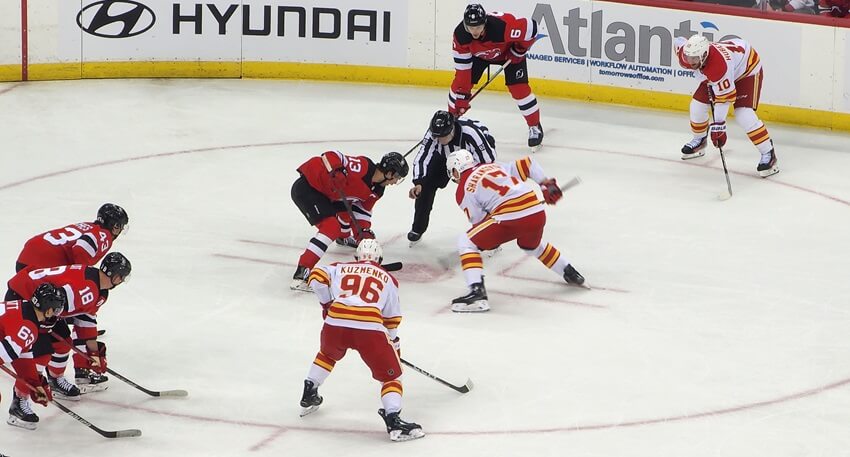NHL, Presidio, and a Transformation Power Move with Hybrid Cloud
Streamlining and updating the flow of information for games and draft night in an effort to help the league reach more fans and boost efficiency.

With the Stanley Cup Playoffs just weeks away, the National Hockey League (NHL) invited a band of reporters to its Manhattan offices, in the shadow of Madison Square Garden, early this week for a behind the scenes discussion of its technology partnership with solutions provider Presidio.
Centralizing data can be crucial for live broadcasts, fan apps, and other needs. Presidio worked with the NHL to establish the league’s Virtual Technical Operations Center (VTOC) to provide a platform for visualizing the performance of live broadcasts of games. The company also helped streamline the complexity of draft night, when teams pick eligible prospects.
It is becoming more and more common for professional sports leagues, from teams in the NFL to Formula One racing teams to the tennis championships at the US Open, to explore technology to enhance fan experience and engagement through broadcasts, apps, and online resources, as well as provide teams and athletes with information to elevate their competitive performance.
David Lehanski, executive vice president of business development and innovation with the NHL, spoke to reporters to lay out some of the transformation ambitions the league has pursued with technology partners that include AWS, Apple, SAP, Verizon, and ServiceNow. “Now Presidio is part of that group,” he said. “We're constantly building a pipeline of initiatives and use cases that we know we want to pursue as a league, built around new technology solutions that ultimately are going to help us grow the game from a fan standpoint, from a revenue standpoint, and otherwise.”

David Lehanski of the NHL. Photo by Joao-Pierre S. Ruth
After vetting potential tech partners, the league typically follows with a pilot, Lehanski said, to see if the vendor is a fit for collaboration.
“We have made a lot of investments in the development of a strategy to obviously, ultimately grow the game, expand our audience, drive more engagement from existing fans,” he said. “A big part for how we’re going to do that is for the creation of new content experiences that have never existed before across multiple formats.”
That has included bringing the NHL to other media such as bringing the NHL Blast metaverse experience to online game Roblox, animated content in collaboration with “Big City Greens,” augmented reality experiences, and virtual reality experiences. “That really starts at the arena, where we’re installing new cameras,” Lehanski said. “We’re expanding on our puck and player tracking solution with optical tracking; we’re capturing new audio feeds; and we see the arena as both a theater, we’re producing a live experience, and a studio where we need to capture that experience and distribute it in various formats to various audiences across the various platforms.”
The NHL brought in Presidio to further its transformation plans, which include enhancing its operations and processes.
Bob Cagnazzi, CEO of Presidio, said the NHL chose his company as part of the journey to modernize the league’s platforms and technical debt. “Dave made it very, very clear -- ‘We’ve got a great game, but not enough people know about it and what we really want to do is make it easier to consume. We want to engage and improve the fan experience and we believe we can use technology in a big way to do that,’” he said. “That’s been the objective that we’ve had collectively since we started working here.”

Bob Cagnazzi of Presidio. Photo by Joao-Pierre S. Ruth
Cagnazzi said Presidio’s experience with some of the legacy platforms the NHL used for years coupled with expertise in current tech helped with the transformation to a hybrid cloud environment. The results include the development of the draft app and the VTOC, he said. “When you’ve got that draft application that’s replacing something that was Lotus Notes -- I programmed in Lotus Notes in the 90s -- or when you’ve got the VTOC, which really helps distribute 1,300 games a year in a digital fashion in a seamless high-performing way, you understand the impact that it makes.”
The NHL Draft app built by Presidio was put into play in 2023, and part of the televised broadcast of the prospects being chosen by league teams. Draft night includes teams reviewing information they have on prospects and entering into the system who they want to bring on board. In prior years, the draft was conducted with each team assigned a specific workstation connected to servers on a private physical network. Presidio and the NHL developed an app that runs on the AWS cloud and on-prem. Phil Filippelli, head of innovation with Presidio, said the transformation plan for the NHL included more than just a modernization of the platform, but to really take advantage of what the technology can offer to make the job easier, as well as make sure that it works and scales.
The VTOC was developed to update how games are broadcast and delivered to fans beyond the arenas. “This was born out of a need to centralize and modernize the way the league was operationalizing the functions from the arena and the broadcast and the encoding of those elements,” said George Santa, client vice president with Presidio. The creation of VTOC with Presidio, he said, allowed the league to reach from the cameras capturing the games, to the broadcast partners, and then to the fans. “Right now, the first iteration of this, we were able to spin up build to a single pane of glass in two weeks,” he said.
Filippelli spoke with InformationWeek, offering further incite on bringing together draft data and other information from the league teams and varied sources to work in one centralized platform.
“Really what we are doing is giving a platform so that more people could see the data sooner because the way the old system used to work is that they would literally pass around flat files,” he said. “Using a relational database and having it in one central spot just gives that much more people access to the information.”
Though Filippelli said there has not been a specific demand to look backward on prior drafts, the centralization of the platform might be useful for further reference. “Looking back from draft to draft, from what I’ve seen, and all the personas that we’ve talked about here, no one really has brought up a need for historical reporting,” he said. However, the larger database includes the birthdates of players, what drafts they are eligible for, and when they are no longer age-appropriate for the draft and can become a free agent. “Things of that nature is all centralized and that then becomes, I think, another data asset for the NHL.”
About the Author(s)
You May Also Like






